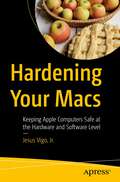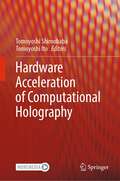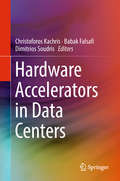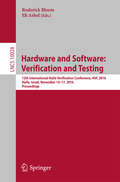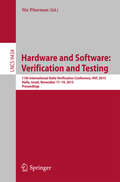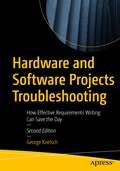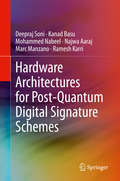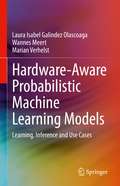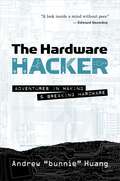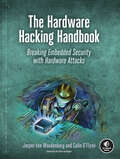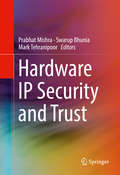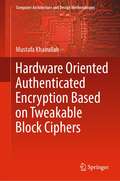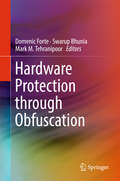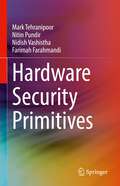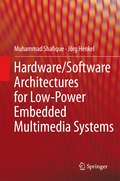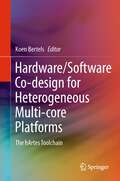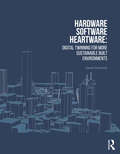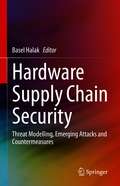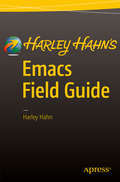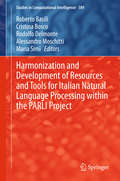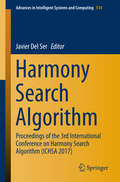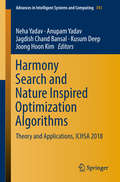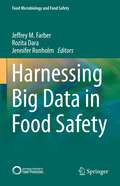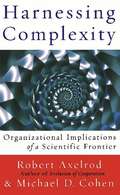- Table View
- List View
Hardening Your Macs: Keeping Apple Computers Safe at the Hardware and Software Level
by Jesus Vigo, Jr.Learn the skills and solutions required to secure your Mac's operating system, the underlying hardware, and allow users to get work done safely. This book will show you how to create a Mac that’s made of steel and won’t buckle when attacked!Ok, there’s no such thing as unhackable. No magic tool or silver bullet will eliminate risk in all forms. Security is an ongoing journey – not a simple action or software application. And that is exactly what you’ll learn to master—the foundational knowledge, skills, and mindset to holistically protect Macs. Regardless of whether it’s your personal iMac or a fleet of MacBook Pro’s assigned to the remote employees within your organization, you’ll be able to limit access while identifying and mitigating risk unique to your environment.In addition to the information security best practices pertaining to protecting Apple computers, you’ll pivot to a coherent, security-focused mindset to better understand macOS-specific security. You’ll learn how it works and what tools and software are available to help. Both native and 3rd-party tool are covered. Safe guard your system’s privacy data and capitalize on effectively locking down the security of your Mac computers against known threats and newer trends that continue to evolve.Hardening Your Macs is the perfect roadmap to stopping malicious attacks and bad actors from spying on users through cameras, microphones, and other built-in tools that could potentially be used against users and organizations alike. What You'll LearnGrasp the mindset of attackers—how they plan and execute malicious incursionsImplement hardware solutions as well as software safeguardsTake advantage of Apple's built-in macOS security features in addition to 3rd party toolsAvoid attacks on your system that could compromise sensitive corporate data and personally identifiable information Who This Book Is ForIT admins responsible for managing Mac device security. Additionally users of Apple products that may have some experience using the platform in general but are not versed in security, as well as, those switching from Windows platforms will find useful information here. And anyone that wishes to expand their information security skills and/or develop a security-focused mindset to better protect their personal information and privacy data from the numerous and growing threats in the wild, such as malware and phishing.
Hardware Acceleration of Computational Holography
by Tomoyoshi Shimobaba Tomoyoshi ItoThis book explains the hardware implementation of computational holography and hardware acceleration techniques, along with a number ofconcrete example source codes that enable fast computation. Computational holography includes computer-based holographictechnologies such as computer-generated hologram and digital holography, for which acceleration of wave-optics computation is highly desirable.This book describes hardware implementations on CPUs (Central Processing Units), GPUs (Graphics Processing Units) and FPGAs (Field ProgrammableGate Arrays).This book is intended for readers involved in holography as well as anyone interested in hardware acceleration.
Hardware Accelerators in Data Centers
by Christoforos Kachris Babak Falsafi Dimitrios SoudrisThis book provides readers with an overview of the architectures, programming frameworks, and hardware accelerators for typical cloud computing applications in data centers. The authors present the most recent and promising solutions, using hardware accelerators to provide high throughput, reduced latency and higher energy efficiency compared to current servers based on commodity processors. Readers will benefit from state-of-the-art information regarding application requirements in contemporary data centers, computational complexity of typical tasks in cloud computing, and a programming framework for the efficient utilization of the hardware accelerators.
Hardware and Software: Verification and Testing
by Roderick Bloem Eli ArbelThis book constitutes the refereed proceedings of the 12th International Haifa Verification Conference, HVC 2016, held in Haifa, Israel in November 2016. The 13 revised full papers and one tool paper presented were carefully reviewed and selected from 26 submissions. They are dedicated to advance the state of the art and state of the practice in verification and testing and are discussing future directions of testing and verification for hardware, software, and complex hybrid systems.
Hardware and Software: Verification and Testing
by Nir PitermanThis book constitutes the refereed proceedings of the11th International Haifa Verification Conference, HVC 2015, held in Haifa,Israel, in November 2015. The 17 revised full papers and 4 invited talks presentedwere carefully reviewed and selected from numerous submissions. The papers areorganized in topical sections on hybrid systems; tools; verification ofrobotics; symbolic execution; model checking; timed systems; SAT solving; multidomain verification; and synthesis.
Hardware and Software Projects Troubleshooting: How Effective Requirements Writing Can Save the Day
by George KoelschLearn how to create good requirements when designing hardware and software systems. While this book emphasizes writing traditional “shall” statements, it also provides guidance on use case design and creating user stories in support of agile methodologies. The book surveys modelling techniques and various tools that support requirements collection and analysis. You’ll learn to manage requirements, including discussions of document types and digital approaches using spreadsheets, generic databases, and dedicated requirements tools. Good, clear examples are presented, many related to real-world work the author has performed during his career. More importantly, you will learn how these techniques can prevent the problems that occur during requirements development. Most of all, you will learn how good requirements governance will greatly increase the success of development projects by getting all people involved to eliminate the adverse impacts to requirements throughout the development lifecycle. Hardware and Software Projects Troubleshooting covers techniques for defining user needs, so you can determine which combination of approaches to use for your projects. You’ll also learn how to analyze the different development methodologies so that you can determine the advantages and disadvantages of different requirements approaches and implement them correctly as your needs evolve. Unlike most requirements books, this one teaches writing both hardware and software requirements because many projects include both areas. To exemplify this approach, two example projects are developed throughout the book, one focusing on hardware, and the other on software. What You Will Learn Focus on how to eliminate or mitigate requirements problemsUnderstand the 14 techniques for capturing all requirementsAddress software and hardware needs; because most projects involve bothEnsure all statements meet the 16 attributes of a good requirementDifferentiate the 19 different functional types of requirements, and the 31 non-functional typesWrite requirements properly based on extensive examples of good ‘shall’ statements, user stories, and use casesEmploy modelling techniques to mitigate the imprecision of wordsInstall requirements governance to significantly improve project success Who This Book Is For Requirements engineers who want to improve and master their craft, as well as students and those employed in government or other organizations at all levels.
Hardware Architectures for Post-Quantum Digital Signature Schemes
by Deepraj Soni Kanad Basu Mohammed Nabeel Najwa Aaraj Marc Manzano Ramesh KarriThis book explores C-based design, implementation, and analysis of post-quantum cryptography (PQC) algorithms for signature generation and verification. The authors investigate NIST round 2 PQC algorithms for signature generation and signature verification from a hardware implementation perspective, especially focusing on C-based design, power-performance-area-security (PPAS) trade-offs and design flows targeting FPGAs and ASICs.Describes a comprehensive set of synthesizable c code base as well as the hardware implementations for the different types of PQC algorithms including lattice-based, code-based, and multivariate-based;Demonstrates the hardware (FPGA and ASIC) and hardware-software optimizations and trade-offs of the NIST round 2 signature-based PQC algorithms;Enables designers to build hardware implementations that are resilient to a variety of side-channels.
Hardware-Aware Probabilistic Machine Learning Models: Learning, Inference and Use Cases
by Wannes Meert Marian Verhelst Laura Isabel Galindez OlascoagaThis book proposes probabilistic machine learning models that represent the hardware properties of the device hosting them. These models can be used to evaluate the impact that a specific device configuration may have on resource consumption and performance of the machine learning task, with the overarching goal of balancing the two optimally. The book first motivates extreme-edge computing in the context of the Internet of Things (IoT) paradigm. Then, it briefly reviews the steps involved in the execution of a machine learning task and identifies the implications associated with implementing this type of workload in resource-constrained devices. The core of this book focuses on augmenting and exploiting the properties of Bayesian Networks and Probabilistic Circuits in order to endow them with hardware-awareness. The proposed models can encode the properties of various device sub-systems that are typically not considered by other resource-aware strategies, bringing about resource-saving opportunities that traditional approaches fail to uncover. The performance of the proposed models and strategies is empirically evaluated for several use cases. All of the considered examples show the potential of attaining significant resource-saving opportunities with minimal accuracy losses at application time. Overall, this book constitutes a novel approach to hardware-algorithm co-optimization that further bridges the fields of Machine Learning and Electrical Engineering.
The Hardware Hacker Adventures in Making and Breaking Hardware
by Andrew Bunnie" HuangFor over a decade, Andrew "bunnie" Huang, one of the world's most esteemed hackers, has shaped the fields of hacking and hardware, from his cult-classic book Hacking the Xbox to the open-source laptop Novena and his mentorship of various hardware startups and developers. In The Hardware Hacker, Huang shares his experiences in manufacturing and open hardware, creating an illuminating and compelling career retrospective. Huang's journey starts with his first visit to the staggering electronics markets in Shenzhen, with booths overflowing with capacitors, memory chips, voltmeters, and possibility. He shares how he navigated the overwhelming world of Chinese factories to bring chumby, Novena, and Chibitronics to life, covering everything from creating a Bill of Materials to choosing the factory to best fit his needs. Through this collection of personal essays and interviews on topics ranging from the legality of reverse engineering to a comparison of intellectual property practices between China and the United States, bunnie weaves engineering, law, and society into the tapestry of open hardware. With highly detailed passages on the ins and outs of manufacturing and a comprehensive take on the issues associated with open source hardware, The Hardware Hacker is an invaluable resource for aspiring hackers and makers.
The Hardware Hacking Handbook: Breaking Embedded Security with Hardware Attacks
by Colin O'Flynn Jasper van WoudenbergThe Hardware Hacking Handbook takes you deep inside embedded devices to show how different kinds of attacks work, then guides you through each hack on real hardware.Embedded devices are chip-size microcomputers small enough to be included in the structure of the object they control, and they&’re everywhere—in phones, cars, credit cards, laptops, medical equipment, even critical infrastructure. This means understanding their security is critical. The Hardware Hacking Handbook takes you deep inside different types of embedded systems, revealing the designs, components, security limits, and reverse-engineering challenges you need to know for executing effective hardware attacks.Written with wit and infused with hands-on lab experiments, this handbook puts you in the role of an attacker interested in breaking security to do good. Starting with a crash course on the architecture of embedded devices, threat modeling, and attack trees, you&’ll go on to explore hardware interfaces, ports and communication protocols, electrical signaling, tips for analyzing firmware images, and more. Along the way, you&’ll use a home testing lab to perform fault-injection, side-channel (SCA), and simple and differential power analysis (SPA/DPA) attacks on a variety of real devices, such as a crypto wallet. The authors also share insights into real-life attacks on embedded systems, including Sony&’s PlayStation 3, the Xbox 360, and Philips Hue lights, and provide an appendix of the equipment needed for your hardware hacking lab – like a multimeter and an oscilloscope – with options for every type of budget. You&’ll learn: • How to model security threats, using attacker profiles, assets, objectives, and countermeasures • Electrical basics that will help you understand communication interfaces, signaling, and measurement • How to identify injection points for executing clock, voltage, electromagnetic, laser, and body-biasing fault attacks, as well as practical injection tips • How to use timing and power analysis attacks to extract passwords and cryptographic keys • Techniques for leveling up both simple and differential power analysis, from practical measurement tips to filtering, processing, and visualizationWhether you&’re an industry engineer tasked with understanding these attacks, a student starting out in the field, or an electronics hobbyist curious about replicating existing work, The Hardware Hacking Handbook is an indispensable resource – one you&’ll always want to have onhand.
Hardware IP Security and Trust
by Prabhat Mishra Swarup Bhunia Mark TehranipoorThis book provides an overview of current Intellectual Property (IP) based System-on-Chip (SoC) design methodology and highlights how security of IP can be compromised at various stages in the overall SoC design-fabrication-deployment cycle. Readers will gain a comprehensive understanding of the security vulnerabilities of different types of IPs. This book would enable readers to overcome these vulnerabilities through an efficient combination of proactive countermeasures and design-for-security solutions, as well as a wide variety of IP security and trust assessment and validation techniques. This book serves as a single-source of reference for system designers and practitioners for designing secure, reliable and trustworthy SoCs.
Hardware Oriented Authenticated Encryption Based on Tweakable Block Ciphers (Computer Architecture and Design Methodologies)
by Mustafa KhairallahThis book presents the use of tweakable block ciphers for lightweight authenticated encryption, especially applications targeted toward hardware acceleration where such efficient schemes have demonstrated competitive performance and strong provable security with large margins. The first part of the book describes and analyzes the hardware implementation aspects of state-of-the-art tweakable block cipher-based mode ΘCB3. With this approach, a framework for studying a class of tweakable block cipher-based schemes is developed and two family of authenticated encryption algorithms are designed for the lightweight standardization project initiated by the National Institute of Standards and Technology (NIST): Romulus and Remus. The Romulus family is a finalist for standardization and targets a wide range of applications and performance trade-offs which will prove interesting to engineers, hardware designers, and students who work in symmetric key cryptography.
Hardware Protection through Obfuscation
by Domenic Forte Swarup Bhunia Mark M. TehranipoorThis book introduces readers to various threats faced during design and fabrication by today's integrated circuits (ICs) and systems. The authors discuss key issues, including illegal manufacturing of ICs or "IC Overproduction," insertion of malicious circuits, referred as "Hardware Trojans", which cause in-field chip/system malfunction, and reverse engineering and piracy of hardware intellectual property (IP). The authors provide a timely discussion of these threats, along with techniques for IC protection based on hardware obfuscation, which makes reverse-engineering an IC design infeasible for adversaries and untrusted parties with any reasonable amount of resources. This exhaustive study includes a review of the hardware obfuscation methods developed at each level of abstraction (RTL, gate, and layout) for conventional IC manufacturing, new forms of obfuscation for emerging integration strategies (split manufacturing, 2. 5D ICs, and 3D ICs), and on-chip infrastructure needed for secure exchange of obfuscation keys- arguably the most critical element of hardware obfuscation.
Hardware Security Primitives
by Mark Tehranipoor Nitin Pundir Nidish Vashistha Farimah FarahmandiThis book provides an overview of current hardware security primitives, their design considerations, and applications. The authors provide a comprehensive introduction to a broad spectrum (digital and analog) of hardware security primitives and their applications for securing modern devices. Readers will be enabled to understand the various methods for exploiting intrinsic manufacturing and temporal variations in silicon devices to create strong security primitives and solutions. This book will benefit SoC designers and researchers in designing secure, reliable, and trustworthy hardware.Provides guidance and security engineers for protecting their hardware designs;Covers a variety digital and analog hardware security primitives and applications for securing modern devices;Helps readers understand PUF, TRNGs, silicon odometer, and cryptographic hardware design for system security.
Hardware/Software Architectures for Low-Power Embedded Multimedia Systems
by Muhammad Shafique Jörg HenkelThis book presents techniques for energy reduction in adaptive embedded multimedia systems, based on dynamically reconfigurable processors. The approach described will enable designers to meet performance/area constraints, while minimizing video quality degradation, under various, run-time scenarios. Emphasis is placed on implementing power/energy reduction at various abstraction levels. To enable this, novel techniques for adaptive energy management at both processor architecture and application architecture levels are presented, such that both hardware and software adapt together, minimizing overall energy consumption under unpredictable, design-/compile-time scenarios.
Hardware/Software Co-design for Heterogeneous Multi-core Platforms: The hArtes Toolchain
by Koen BertelsHW/SW Co-Design for Heterogeneous Multi-Core Platforms describes the results and outcome of the FP6 project which focuses on the development of an integrated tool chain targeting a heterogeneous multi core platform comprising of a general purpose processor (ARM or powerPC), a DSP (the diopsis) and an FPGA. The tool chain takes existing source code and proposes transformations and mappings such that legacy code can easily be ported to a modern, multi-core platform. Downloadable software will be provided for simulation purposes.
Hardware, Software, Heartware: Digital Twinning for More Sustainable Built Environments
by Jason PomeroyThis richly illustrated book examines the full potential of Digital Twins (DTs) as a means of creating more sustainable urban habitats. It reveals how, in this digitally-enabled age, DTs are increasingly being adopted by cities as a tool for urban governance, with the hope of increasing operational efficiencies and enhancing citizens’ lives. While the study and implementation of DTs has been critically explored as virtual, dynamic 3D replicas of physical entities across different disciplines and industries, this book establishes a strategy that recognises the need for the ‘software’ behind virtual DT platforms to not only represent the ‘hardware’ of our physical cities but also to reflect the ‘heartware’ of socio-economic and cultural practices. Knowledge gaps and challenges in existing DTs are identified and insights into rethinking their purpose are provided to propose a new DT paradigm model for city-wide application. With multiple case studies illustrating the different concepts of DTs being applied in cities from Europe, North America, The Middle East, Asia and Oceania, the book highlights the reasons why and how DTs can play an integral role in the sustainability of our urban habitats. Beautifully designed and illustrated in full colour throughout, this book combines academic theory with practical application and will be a useful reference for professionals, students, academics and policymakers, working in the fields of smart cities, sustainable urbanism, and the digitisation, digitalisation and digital transformation of the built environment industry.
Hardware Supply Chain Security: Threat Modelling, Emerging Attacks and Countermeasures
by Basel HalakThis book presents a new threat modelling approach that specifically targets the hardware supply chain, covering security risks throughout the lifecycle of an electronic system. The authors present a case study on a new type of security attack, which combines two forms of attack mechanisms from two different stages of the IC supply chain. More specifically, this attack targets the newly developed, light cipher (Ascon) and demonstrates how it can be broken easily, when its implementation is compromised with a hardware Trojan. This book also discusses emerging countermeasures, including anti-counterfeit design techniques for resources constrained devices and anomaly detection methods for embedded systems.
Harley Hahn's Emacs Field Guide
by Harley HahnEmacs, the world's most powerful text editor-based work environment, is easy to use, but far from easy to learn. As such, integrating Emacs into your personal world of thinking and creating is a long-term process. Harley Hahn, one of the most respected technical authors in the world, makes learning fun and stimulating. In this book, Hahn demystifies Emacs for programmers, students, and everyday users. The first part of the book carefully creates a context for your work with Emacs. What exactly is Emacs? How does it relate to your personal need to work quickly and to solve problems? Hahn then explains the technical details you need to understand to work with your operating system, the various interfaces, and your file system. In the second part of the book, Hahn provides an authoritative guide to the fundamentals of thinking and creating within the Emacs environment. You start by learning how to install and use Emacs with Linux, BSD-based Unix, Mac OS X, or Microsoft Windows. Written with Hahn's clear, comfortable, and engaging style, Harley Hahn's Emacs Field Guide will surprise you: an engaging book to enjoy now, a comprehensive reference to treasure for years to come. What you'll learn Special Emacs keys Emacs commands Buffers and windows Cursor, point, and region Kill/delete, move/copy, correcting, spell checking, and filling Searching, including regular expressions Emacs major modes and minor modes Customizing using your . emacs file Built-in tools, including Dired Games and Diversions Who this book is for Harley Hahn's Emacs Field Guide' is for programmers, students, and everyday users, who want an engaging and authoritative introduction to the complex and powerful Emacs working environment.
Harmonization and Development of Resources and Tools for Italian Natural Language Processing within the PARLI Project
by Roberto Basili Cristina Bosco Rodolfo Delmonte Alessandro Moschitti Maria SimiThe papers collected in this volume are selected as a sample of the progress in Natural Language Processing (NLP) performed within the Italian NLP community and especially attested by the PARLI project. PARLI (Portale per l'Accesso alle Risorse in Lingua Italiana) is a project partially funded by the Ministero Italiano per l'Università e la Ricerca (PRIN 2008) from 2008 to 2012 for monitoring and fostering the harmonic growth and coordination of the activities of Italian NLP. It was proposed by various teams of researchers working in Italian universities and research institutions. According to the spirit of the PARLI project, most of the resources and tools created within the project and here described are freely distributed and they did not terminate their life at the end of the project itself, hoping they could be a key factor in future development of computational linguistics.
Harmonizing Global Education: From Genghis Khan to Facebook (Open and Flexible Learning Series)
by Jon BaggaleyDistance education (DE) offers ways to reach the many people around the world who lack access to education and training by other means. International DE methods, however, are fragmented, and distance educators have often abandoned new technologies before giving them a chance to develop. As a result, many current DE tools and techniques are incompatible with the needs and cultures of different global regions. With the goal of designing efficient, relevant DE for worldwide audiences, Harmonizing Global Education invites scholars and practitioners to consider the historic development of technology-based education and communication studies, going back further in the literature than is often assumed necessary. The book examines a wide range of historical ideas capable of shaping modern DE, including the Luddite Revolt among British textiles workers in 1811-12, the evolution of cubist art and musical aesthetics, and the visionary advances of early twentieth-century Soviet multimedia specialists. The author urges an awareness of previous generations of communications studies, and shows how audience research relating to traditional media can be relevant in the design of current internet-based and social media approaches. Today's open universities have grown from these earlier historical efforts, and the future success of open and distance education depends on learning from the successes and the failures of the past.
Harmony Search Algorithm
by Javier Del SerThis book presents state-of-the-art technical contributions based around one of the most successful evolutionary optimization algorithms published to date: Harmony Search. Contributions span from novel technical derivations of this algorithm to applications in the broad fields of civil engineering, energy, transportation & mobility and health, among many others and focus not only on its cross-domain applicability, but also on its core evolutionary operators, including elements inspired from other meta-heuristics. The global scientific community is witnessing an upsurge in groundbreaking, new advances in all areas of computational intelligence, with a particular flurry of research focusing on evolutionary computation and bio-inspired optimization. Observed processes in nature and sociology have provided the basis for innovative algorithmic developments aimed at leveraging the inherent capability to adapt characterized by various animals, including ants, fireflies, wolves and humans. However, it is the behavioral patterns observed in music composition that motivated the advent of the Harmony Search algorithm, a meta-heuristic optimization algorithm that over the last decade has been shown to dominate other solvers in a plethora of application scenarios. The book consists of a selection of the best contributions presented at ICHSA, a major biannual event where leading global experts on meta-heuristic optimization present their latest findings and discuss the past, present, and future of the exciting field of Harmony Search optimization. It provides a valuable reference resource for researchers working in the field of optimization meta-heuristics, and a solid technical base for frontline investigations around this algorithm.
Harmony Search and Nature Inspired Optimization Algorithms: Theory and Applications, ICHSA 2018 (Advances in Intelligent Systems and Computing #741)
by Neha Yadav Anupam Yadav Jagdish Chand Bansal Kusum Deep Joong Hoon KimThe book covers different aspects of real-world applications of optimization algorithms. It provides insights from the Fourth International Conference on Harmony Search, Soft Computing and Applications held at BML Munjal University, Gurgaon, India on February 7–9, 2018. It consists of research articles on novel and newly proposed optimization algorithms; the theoretical study of nature-inspired optimization algorithms; numerically established results of nature-inspired optimization algorithms; and real-world applications of optimization algorithms and synthetic benchmarking of optimization algorithms.
Harnessing Big Data in Food Safety (Food Microbiology and Food Safety)
by Jeffrey M. Farber Rozita Dara Jennifer RonholmBig Data technologies have the potential to revolutionize the agriculture sector, in particular food safety and quality practices. This book is designed to provide a foundational understanding of various applications of Big Data in Food Safety. Big Data requires the use of sophisticated approaches for cleaning, processing and extracting useful information to improve decision-making. The contributed volume reviews some of these approaches and algorithms in the context of real-world food safety studies. Food safety and quality related data are being generated in large volumes and from a variety of sources such as farms, processors, retailers, government organizations, and other industries. The editors have included examples of how big data can be used in the fields of bacteriology, virology and mycology to improve food safety. Additional chapters detail how the big data sources are aggregated and used in food safety and quality areas such as food spoilage and quality deterioration along the supply chain, food supply chain traceability, as well as policy and regulations. The volume also contains solutions to address standardization, data interoperability, and other data governance and data related technical challenges. Furthermore, this volume discusses how the application of machine-learning has successfully improved the speed and/or accuracy of many processes in the food supply chain, and also discusses some of the inherent challenges. Included in this volume as well is a practical example of the digital transformation that happened in Dubai, with a particular emphasis on how data is enabling better decision-making in food safety. To complete this volume, researchers discuss how although big data is and will continue to be a major disruptor in the area of food safety, it also raises some important questions with regards to issues such as security/privacy, data control and data governance, all of which must be carefully considered by governments and law makers.
Harnessing Complexity: Organizational Implications of a Scientific Frontier
by Robert Axelrod Michael D. CohenHarnessing Complexity will be indispensable to anyone who wants to better comprehend how people and organizations can adapt effectively in the information age. This book is a step-by-step guide to understanding the processes of variation, interaction, and selection that are at work in all organizations. The authors show how to use their own paradigm of "bottom up" management, the Complex Adaptive System-whether in science, public policy, or private commerce. This simple model of how people work together will change forever how we think about getting things done in a group. "Harnessing Complexity distills the managerial essence of current research on complexity. #133;A very valuable contribution to the emerging theory of competition and competitive advantage. "-C. K. Prahalad, University of Michigan, coauthor of Competing for the Future"A brilliant exposition that demystifies both the theory and use of Complex Adaptive Systems. "-John Seely Brown, Xerox Corporation and Palo Alto Research Center
